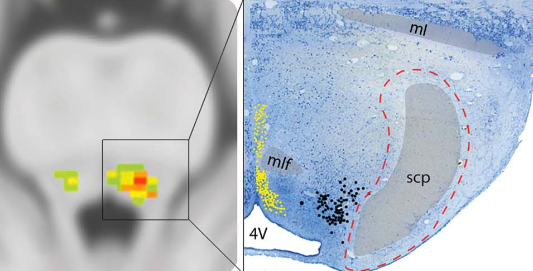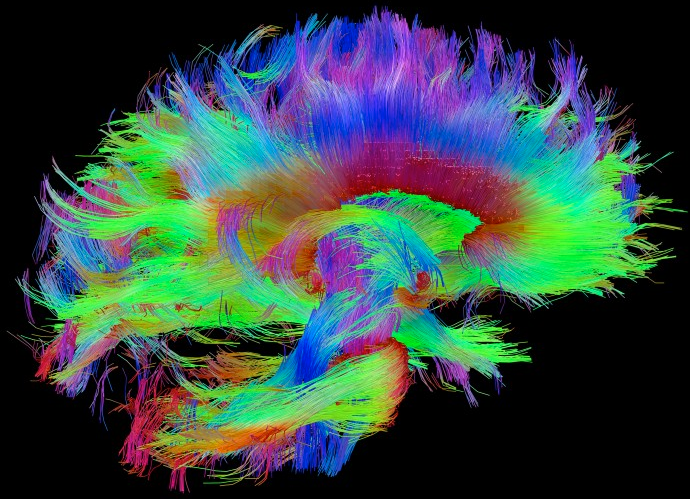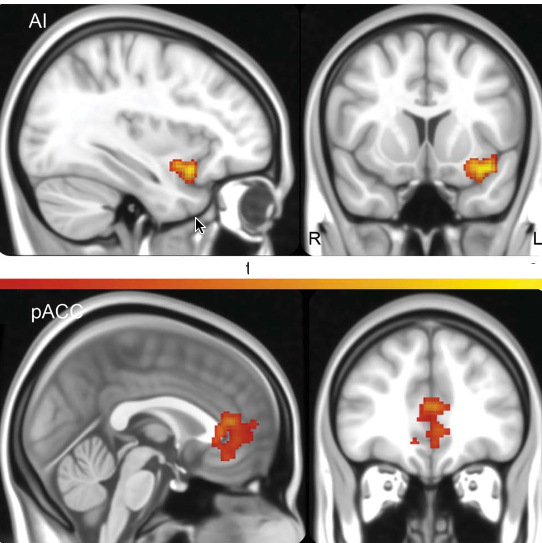Could these three brain regions be the seat of consciousness?
November 10, 2016

(Left) A coma-specific region in the left pontine tegmentum in the brainstem (red). (Right) Multiple nuclei implicated in arousal surround the coma-specific region, including the dorsal raphe (yellow dots), locus coeruleus (black dots), and parabrachial nucleus (red dashed line). (credit: David B. Fischer, MD et al./Neurology)
An international team of neurologists led by Beth Israel Deaconess Medical Center (BIDMC) has identified three specific regions of the brain that appear to be critical components of consciousness: one in the brainstem, involved in arousal; and two cortical regions involved in awareness.
To pinpoint the exact regions, the neurologists first analyzed 36 patients with brainstem lesions (injuries). They discovered that a specific small area of the brainstem — the pontine tegmentum (specifically, the rostral dorsolateral portion) — was significantly associated with coma.* (The brainstem connects the brain with the spinal cord and is responsible for the sleep/wake cycle and cardiac and respiratory rates.)

Human connectome (credit: Human Connectome Project)
Once they had identified the area involved in arousal, they next looked to see which cortical regions were connected to this arousal area and also become disconnected in disorders of consciousness. To do that, they used the Human Connectome — a sort of wiring diagram of the brain.
Thanks to the connectome, “we can look at not just the location of lesions, but also their connectivity,” said Michael D. Fox, MD, PhD, Director of the Laboratory for Brain Network Imaging and Modulation and the Associate Director of the Berenson-Allen Center for Noninvasive Brain Stimulation at BIDMC.

The coma-specific brainstem region is functionally connected to clusters in the anterior insula (AI) and pregenual anterior cingulate cortex (pACC). Voxels within these nodes were functionally connected to all 12 coma lesions, and were more functionally connected to coma lesions than control lesions. (credit: David B. Fischer, MD et al./Neurology)
They discovered two connected cortical regions: the pregenual anterior cingulate cortex (pACC) and the left ventral anterior insula (AI). Both regions were previously implicated in both arousal and awareness.
“Over the past year, researchers in my lab have used this approach to understand visual and auditory hallucinations, impaired speech, and movement disorders,” said Fox. “A collaborative team of neuroscientists and physicians had the insight and unique expertise needed to apply this approach to consciousness.”
Consciousness network
Finally, the team investigated whether this brainstem-cortex network was functioning in another subset of patients with disorders of consciousness, including coma. Using a special type of MRI scan, the scientists found that their newly identified “consciousness network” was disrupted in patients with impaired consciousness.
Published recently in the journal Neurology, the findings — bolstered by data from rodent studies — suggest that the network between the brainstem and these two cortical regions plays a role in maintaining human consciousness.
A next step, Fox notes, may be to investigate other data sets in which patients lost consciousness to find out if the same, different, or overlapping neural networks are involved.
“This is most relevant if we can use these networks as a target for brain stimulation for people with disorders of consciousness,” said Fox. “If we zero in on the regions and network involved, can we someday wake someone up who is in a persistent vegetative state? That’s the ultimate question.”
Researchers at the University of Iowa Carver College of Medicine, the Brain and Spine Institute (Institut du Cerveau et de la Moelle épinière-ICM) at Hôpital Pitié-Salpêtrière, University and University Hospital of Liège, the Comparative Neuroanatomy Lab and the Centre for Integrative Neuroscience in Tübingen, the Max Planck Institute for Biological Cybernetics, and Massachusetts General Hospital were also involved.
This work was supported by the Howard Hughes Medical Institute, the Parkinson’s Disease Foundation, NIH, American Academy of Neurology/American Brain Foundation, Sidney R. Baer, Jr. Foundation, Harvard Catalyst, the Belgian National Funds for Scientific Research, the European Commission, the James McDonnell Foundation, the European Space Agency, Mind Science Foundation, the French Speaking Community Concerted Research Action, the Public Utility Foundation “Université Européenne du Travail,” Fondazione Europea di Ricerca Biomedica, the University and University Hospital of Liège, the Center for Integrative Neuroscience, and the Max Planck Society.
* 12 lesions led to coma and 24 (the control group) did not. Ten out of the 12 coma-inducing brainstem lesions were involved in this area, while just one of the 24 control lesions was.
Abstract of A human brain network derived from coma-causing brainstem lesions
Objective: To characterize a brainstem location specific to coma-causing lesions, and its functional connectivity network.
Methods: We compared 12 coma-causing brainstem lesions to 24 control brainstem lesions using voxel-based lesion-symptom mapping in a case-control design to identify a site significantly associated with coma. We next used resting-state functional connectivity from a healthy cohort to identify a network of regions functionally connected to this brainstem site. We further investigated the cortical regions of this network by comparing their spatial topography to that of known networks and by evaluating their functional connectivity in patients with disorders of consciousness.
Results: A small region in the rostral dorsolateral pontine tegmentum was significantly associated with coma-causing lesions. In healthy adults, this brainstem site was functionally connected to the ventral anterior insula (AI) and pregenual anterior cingulate cortex (pACC). These cortical areas aligned poorly with previously defined resting-state networks, better matching the distribution of von Economo neurons. Finally, connectivity between the AI and pACC was disrupted in patients with disorders of consciousness, and to a greater degree than other brain networks.
Conclusions: Injury to a small region in the pontine tegmentum is significantly associated with coma. This brainstem site is functionally connected to 2 cortical regions, the AI and pACC, which become disconnected in disorders of consciousness. This network of brain regions may have a role in the maintenance of human consciousness.